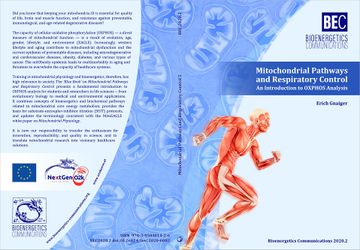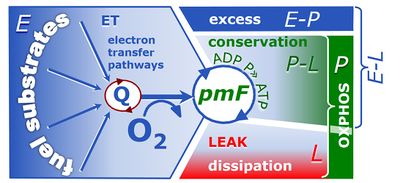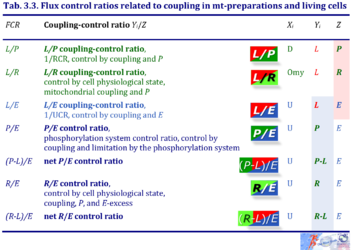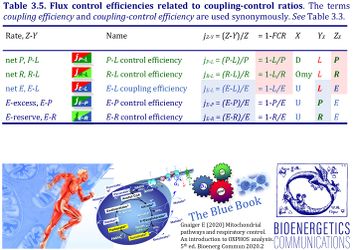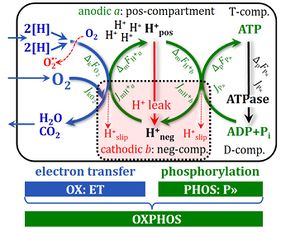Hyphenation: Difference between revisions
No edit summary |
No edit summary |
||
| Line 4: | Line 4: | ||
}} | }} | ||
{{MitoPedia concepts | {{MitoPedia concepts | ||
|mitopedia concept=Respiratory state, Respiratory control ratio | |mitopedia concept=Respiratory state, Respiratory control ratio | ||
}} | }} | ||
{{MitoPedia methods}} | {{MitoPedia methods}} | ||
{{MitoPedia O2k and high-resolution respirometry}} | {{MitoPedia O2k and high-resolution respirometry | ||
|mitopedia O2k and high-resolution respirometry=Oroboros QM | |||
}} | |||
{{MitoPedia topics | {{MitoPedia topics | ||
|mitopedia topic=BEC | |mitopedia topic=BEC | ||
Revision as of 05:11, 19 July 2022
Description
Hyphenation is used to connect two words (compound words) or two parts of a word to clarify the meaning of a sentence. The same two words may be hyphenated or not depending on context. Hyphenation may present a problem when searching for a term such as 'Steady state'. It is helpful to write 'steady-state measurement', to clarify that the measurement is performed at steady state, rather than implying that a state measurement is steady. But this does not imply that hyphenation is applied to the 'measurement performed at steady state'. Thus, the key word is 'steady state'. Compound adjectives should be hyphenated (steady-state measurement), but if the compound adjective follows the term (measurement at steady state), hyphenation does not add any information and should be avoided. Find more examples and guidelines in the grammarly blog on Hyphen and in apastyle.apa.org.
Reference: Steady state
MitoPedia concepts:
Respiratory state,
Respiratory control ratio
MitoPedia O2k and high-resolution respirometry: Oroboros QM
MitoPedia topics:
BEC
Communicated by Gnaiger Erich (2020-06-02) last update 2020-11-11
Examples on respiratory states and rates
- Changes from MitoFIT preprint Gnaiger 2019 MitoFit Preprint Arch to BEC 2020.1 and extension in Gnaiger 2020 BEC MitoPathways
- 'State of coupling control' and 'Coupling state', but Coupling-control state (NOT 'Coupling control state' - it is not 'coupling of a control state')
- Coupling-control ratio, Coupling-control state; but: P/E control ratio (if the name contains a fraction such as P/E or difference such as P-L, then no hyphen follows these symbols, to avoid confusion between the minus sign and the hyphen).
- Coupling-control protocol
- Uncoupling-control ratio; ROUTINE-control ratio
- LEAK respiration (NOT LEAK-respiratory state); LEAK rate (NOT LEAK-rate; but: LEAK-rate dependent flux control efficiency)
- OXPHOS capacity, but: OXPHOS-coupling efficiency
- Phosphorylation pathway, but: Phosphorylation-pathway capacity
- Electron transfer pathway and ET state, but: Electron-transfer-pathway state, ET-pathway state, E-L coupling efficiency
- ET capacity, but: 'ET- or OXPHOS capacity'
- ET-excess capacity, but: E-P excess ET capacity
- ROX state, but: ROX-linked oxygen consumption; Rox-corrected LEAK respiration
- NADH pathway, but: NS-linked respiration; special cases: N-pathway, NS-pathway
- Succinate pathway, but: Succinate-linked pathway; special case: S-pathway
- Some less clear examples
- Pathway-control state: 'Pathway control state' would be simpler and the meaning is clear, but in line with Coupling-control state it makes sense to use similarly the hyphen in 'Pathway-control state'.
- OXPHOS-control ratio, but: Respiratory control ratio, Respiratory acceptor control ratio
- Flux control ratio and Flux control efficiency: there is no need to use a hyphen.
- Electron-transfer-pathway state - and should 'ET-pathway competent states' then be ET-pathway-competent states'?
- N-junction, Q-junction, Convergent ET-junctions (but: ET pathway)
- NS-pathway, PM-pathway; but: 'pyruvate-malate pathway' (NOT pyruvate&malate pathway); pyruvate-glutamate-malate substrate combination
- Re-evaluation is required
References
| Bioblast link | Reference | Year |
|---|---|---|
| BEC 2020.1 doi10.26124bec2020-0001.v1 | Gnaiger E et al ― MitoEAGLE Task Group (2020) Mitochondrial physiology. Bioenerg Commun 2020.1. https://doi.org/10.26124/bec:2020-0001.v1 | 2020 |
Keywords
4-compartmental OXPHOS model. (1) ET capacity E of the noncoupled electron transfer system ETS. OXPHOS capacity P is partitioned into (2) the dissipative LEAK component L, and (3) ADP-stimulated P-L net OXPHOS capacity. (4) If P-L is kinetically limited by a low capacity of the phosphorylation system to utilize the protonmotive force pmF, then the apparent E-P excess capacity is available to drive coupled processes other than phosphorylation P» (ADP to ATP) without competing with P».
- Bioblast links: Coupling control - >>>>>>> - Click on [Expand] or [Collapse] - >>>>>>>
1. Mitochondrial and cellular respiratory rates in coupling-control states
| Respiratory rate | Defining relations | Icon | |
|---|---|---|---|
| OXPHOS capacity | P = P´-Rox | mt-preparations | |
| ROUTINE respiration | R = R´-Rox | living cells | |
| ET capacity | E = E´-Rox | » Level flow | |
| » Noncoupled respiration - Uncoupler | |||
| LEAK respiration | L = L´-Rox | » Static head | |
| » LEAK state with ATP | |||
| » LEAK state with oligomycin | |||
| » LEAK state without adenylates | |||
| Residual oxygen consumption Rox | L = L´-Rox |
2. Flux control ratios related to coupling in mt-preparations and living cells
| FCR | Definition | Icon | |
|---|---|---|---|
| L/P coupling-control ratio | L/P | » Respiratory acceptor control ratio, RCR = P/L | |
| L/R coupling-control ratio | L/R | ||
| L/E coupling-control ratio | L/E | » Uncoupling-control ratio, UCR = E/L (ambiguous) | |
| P/E control ratio | P/E | ||
| R/E control ratio | R/E | » Uncoupling-control ratio, UCR = E/L | |
| net P/E control ratio | (P-L)/E | ||
| net R/E control ratio | (R-L)/E |
3. Net, excess, and reserve capacities of respiration
| Respiratory net rate | Definition | Icon |
|---|---|---|
| P-L net OXPHOS capacity | P-L | |
| R-L net ROUTINE capacity | R-L | |
| E-L net ET capacity | E-L | |
| E-P excess capacity | E-P | |
| E-R reserve capacity | E-R |
4. Flux control efficiencies related to coupling-control ratios
| Coupling-control efficiency | Definition | Icon | Canonical term | ||
|---|---|---|---|---|---|
| P-L control efficiency | jP-L | = (P-L)/P | = 1-L/P | P-L OXPHOS-flux control efficiency | |
| R-L control efficiency | jR-L | = (R-L)/R | = 1-L/R | R-L ROUTINE-flux control efficiency | |
| E-L coupling efficiency | jE-L | = (E-L)/E | = 1-L/E | E-L ET-coupling efficiency » Biochemical coupling efficiency | |
| E-P control efficiency | jE-P | = (E-P)/E | = 1-P/E | E-P ET-excess flux control efficiency | |
| E-R control efficiency | jE-R | = (E-R)/E | = 1-R/E | E-R ET-reserve flux control efficiency |
5. General
- » Basal respiration
- » Cell ergometry
- » Dyscoupled respiration
- » Dyscoupling
- » Electron leak
- » Electron-transfer-pathway state
- » Hyphenation
- » Oxidative phosphorylation
- » Oxygen flow
- » Oxygen flux
- » Permeabilized cells
- » Phosphorylation system
- » Proton leak
- » Proton slip
- » Respiratory state
- » Uncoupling
- Bioblast links: Uncoupling - >>>>>>> - Click on [Expand] or [Collapse] - >>>>>>>
- Specific
- » Artefacts by single dose uncoupling
- » ATP synthase
- » CCCP
- » Coupling-control protocol
- » DNP
- » Dyscoupled respiration
- » FCCP
- » Is respiration uncoupled - noncoupled - dyscoupled?
- » Noncoupled respiration: Discussion
- » Uncoupler
- » Uncoupled respiration - see » Noncoupled respiration
- » Uncoupling proteins
- » Uncoupling protein 1
- » Uncoupler titrations - Optimum uncoupler concentration
- Specific
- Respiratory states and control ratios
- » Biochemical coupling efficiency
- » Coupling-control state
- » Electron-transfer-pathway state
- » Electron-transfer pathway
 ET capacity
ET capacity- » E-L coupling efficiency
- » Flux control efficiency
- » Flux control ratio
- » LEAK-control ratio
- » LEAK respiration
- » Noncoupled respiration
- » OXPHOS
- » OXPHOS capacity; » State 3
- » OXPHOS-control ratio, P/E ratio
- » Respiratory acceptor control ratio
- » ROUTINE-control ratio
- » ROUTINE respiration
- » ROUTINE state
- » State 3u
- » State 4
- » Uncoupling-control ratio UCR
- Respiratory states and control ratios
- Gnaiger E et al ― MitoEAGLE Task Group (2020) Mitochondrial physiology. Bioenerg Commun 2020.1. https://doi.org/10.26124/bec:2020-0001.v1
- Gnaiger E (2020) Mitochondrial pathways and respiratory control. An introduction to OXPHOS analysis. 5th ed. Bioenerg Commun 2020.2. https://doi.org/10.26124/bec:2020-0002
- General (alphabetical order)
- Other keyword lists

